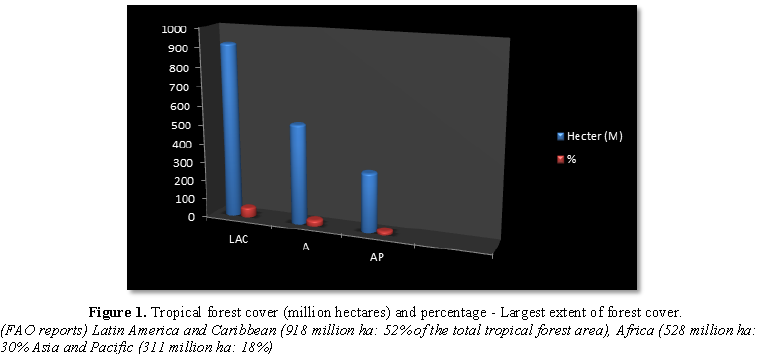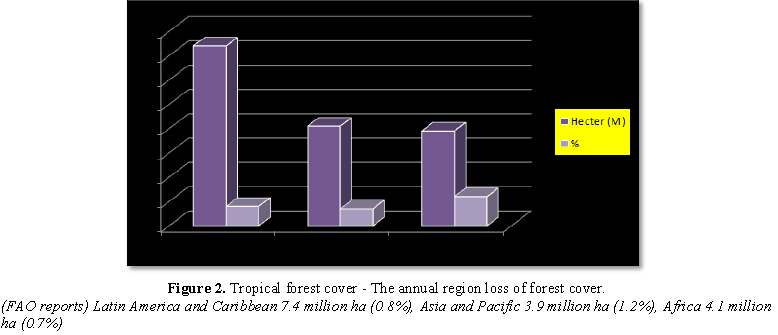593
Views & Citations10
Likes & Shares
INTRODUCTION
There has been a greater concern for rapid deteriorating
issues of forest conservation in the aspects of exploitation in forest
ecosystem especially in the developing world. The scramble for fuel wood and
timber has increased. Forest regeneration, natural regeneration, industrial
plantation and wasteful logging have been identified as critical problems. All
these have led to over exploitation and misuse of forest resources thereby no
policy for the maintenance and sustainability of ever growing complex ecosystem
rather increase exploitation and poor conservation approach especially forest
and forest resources. Global change ecology and forest degradation results to
diminishing of resources as well as poor forest management strategies leaving
increased exploitation over wild scale land use and forest resources.
FOREST DESTRUCTION
Documented evidences shows that shifting
cultivation is age long predominant agricultural system practices in Africa
which has been associated in felling and burning of vegetation of the natural
forest, secondary and savannah woodlands. The destruction of soil and climate
dependent is another serious issue in forest deterioration. However, some
literature evidences claimed shifting cultivation to be effective in
environmental restoration but most diminishing factor is the soil environmental
biodiversity (soil-micro fauna wild life vegetation matrix). The soil
environmental biodiversity is known to protect sensitive ecosystems though the
clearing effect may result to irreversibility. Generally, some unsustainable
farming practices need to be replaced considering its agro ecological and
environmental concept because it is categorized as a degrading farming
practice.
Main factors of forest degradation
a. Degradation is
a consequences arising from shifting cultivation leading to erosion and gullies
in sensitive forest sites.
b. Frequent fire
results to the destruction of fire-sensitive species of trees and shrubs and
soil fauna thereby may set in some favorable conditions for the invasion of
grass species. It is scientifically accepted that protracted cultivation may
result to vulnerability of bare ground and wind, soil and water erosion.
c. The scrambling
for wood and forest resources in the content of fuel wood and charcoal
production as well as non-wood resources account over 90% of wood consumption
around the globe. Most ecological zones have been exploited either under
consumption pattern and misuse of forest resources. Urbanization also has
attracted wide use of forest resources even in the concept of environmental
needs and services of urban vegetation/forestry needs.
d. The need for
charcoal and energy sources has corresponding effect on global forest and
vegetation, that is to say, it has effect on soil nutrients. This leads to
wider deforestation of global forests.
e. Poor household
and local agricultural practices especially in the developing world has also
posed serious consequences on forestry standard and ratings.
f. Lack of
appropriate technology and investment in the natural forest and forest
ecosystem management adversely leads to forest degradation. This implies that
forest degradation may correspondingly contribute to deterioration of quality
of life in both urban forestry needs and other human needs globally.
g. Forest degradation influences the earth’s climatic factors such as wind reduction, albedo and other forest ecosystem feedback mechanisms in which some influences may results to irreversible climatologically.
Deforestation
Deforestation processes include loss of
forest by change by physiognomic characteristics thereby changing forest to
shrubs and establishment (common in Africa) of traditional short time fallow in
agricultural practice. Deforestation in loss of woody biomass which results to
destruction of forest to non-wooded areas which identifies extreme level of
degradation (denuded land) leaving the areas into permanent agriculture status.
TROPICAL FOREST
CONSERVATION STRATEGIES
Conservation of tropical forests are
concerted efforts designed to sustain and maximize the care and reduction of the
damage, sustain greater number of forest species while maintaining more species
in the value for forest conservation purposes. This concept considers larger
the original area of the forest, the greater the number of species within more
diverse the topography and soil, the greater the number of species. This is to
say, that different topographical area may contain endemic species for the
attainment of valuable species (forest products). Conservation means the need
for protection while conserving a viable species population in the maintenance
of a sufficient essential forest area and for all types of forest preservation.
Table 1 below outlines some major
tropical forest conservation strategies that can be acceptable and of global
application [1-6].
1. FAO (1988) An interim report on
the state of forest resources in the developing countries. Rome, Italy.
2. FAO/UNEP (1982) Tropical forest
resources. Forestry Paper No. 30, Rome, Italy.
3. FAO (1985) Intensive multiple-use
forest management in the tropics. Forestry Paper No. 55, Rome, Italy.
4. FAO (1988) An interim report on
the state of forest resources in the developing countries. Rome, Italy.
5. FAO (1989) Management of tropical
moist forests in Africa. Forestry Paper No. 88, Rome, Italy
6. FAO (1989) Review of forest
management systems of tropical Asia. Forestry Paper No. 89, Rome, Italy.
QUICK LINKS
- SUBMIT MANUSCRIPT
- RECOMMEND THE JOURNAL
-
SUBSCRIBE FOR ALERTS
RELATED JOURNALS
- Journal of Astronomy and Space Research
- Advances in Nanomedicine and Nanotechnology Research (ISSN: 2688-5476)
- Journal of Veterinary and Marine Sciences (ISSN: 2689-7830)
- Proteomics and Bioinformatics (ISSN:2641-7561)
- Journal of Microbiology and Microbial Infections (ISSN: 2689-7660)
- Journal of Genetics and Cell Biology (ISSN:2639-3360)
- Journal of Biochemistry and Molecular Medicine (ISSN:2641-6948)



